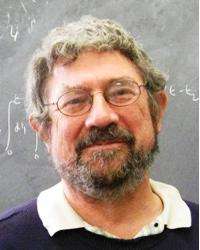J. Michael Kosterlitz
| Michael Kosterlitz | |
|---|---|
 | |
| Born |
John Michael Kosterlitz June 22, 1943[1] Aberdeen, Scotland |
| Residence | Providence, Rhode Island, U.S. |
| Citizenship | United States |
| Nationality | British |
| Fields | Condensed matter physics |
| Institutions | Brown University |
| Alma mater |
|
| Thesis | Problems in strong interaction physics (1969) |
| Academic advisors | David Thouless (postdoc) |
| Known for | Kosterlitz–Thouless transition |
| Notable awards |
|
|
Website vivo | |
John Michael Kosterlitz (born June 22, 1943) is a British born professor of physics at Brown University[4] and the son of biochemist Hans Kosterlitz. He was awarded the 2016 Nobel Prize in physics along with David Thouless and Duncan Haldane for work on condensed matter physics.[2]
Education and Life
He was born in Aberdeen, Scotland,[5] to German Jewish émigrés, the son of the pioneering biochemist[6] Hans Walter Kosterlitz and Hannah Gresshöner. He received his Bachelor of Arts degree, subsequently converted to a Master of Arts degree, at Gonville and Caius College, Cambridge.[5] In 1969, he earned a Doctor of Philosophy degree[7] from the University of Oxford as a postgraduate student of Brasenose College, Oxford.[5] Kosterlitz is a US citizen.
Career and research
After a few postdoctoral positions, including positions at the University of Birmingham, collaborating with David Thouless,[5] and at Cornell University,[5] he was appointed to the faculty of the University of Birmingham in 1974,[5] first as a lecturer and, later, as a reader. Since 1982, he has been professor of physics at Brown University. Kosterlitz is currently a visiting research fellow at Aalto University in Finland and since 2016 a distinguished professor at Korea Institute for Advanced Study.
Kosterlitz does research in condensed matter theory, one- and two-dimensional physics; in phase transitions: random systems, electron localization, and spin glasses; and in critical dynamics: melting and freezing.
Awards and honours
Michael Kosterlitz was awarded the Nobel Prize in Physics in 2016,[8] the Maxwell Medal and Prize from the British Institute of Physics in 1981, and the Lars Onsager Prize from the American Physical Society in 2000, especially, for his work on the Kosterlitz–Thouless transition. Since 1993, he has been a Fellow of the American Physical Society.
The Kosterlitz Centre at the University of Aberdeen is named in honour of his father, Hans Kosterlitz, a pioneering biochemist specializing in endorphins, who joined the faculty after fleeing Nazi persecution of Jews in 1934.[9]
References
- ↑ "J. Michael Kosterlitz - Facts". Nobel Foundation. Retrieved 2016-11-02.
- 1 2 Gibney, Elizabeth; Castelvecchi, Davide (2016). "Physics of 2D exotic matter wins Nobel: British-born theorists recognized for work on topological phases". Nature. London: Springer Nature. 538 (7623): 18–18. doi:10.1038/nature.2016.20722.
- ↑ "Lars Onsager recipient 2000, John Michael Kosterlitz Brown University". aps.org. American Physical Society.
- ↑ "Kosterlitz Research profile at Brown University". brown.edu. Brown University.
- 1 2 3 4 5 6 "Two former Birmingham scientists awarded Nobel Prize for Physics". University of Birmingham. 4 October 2016. Retrieved 4 October 2016.
- ↑ Anatomy of a Scientific Discovery: The Race to Find the Body's Own Morphine, by Jeff Goldberg, Skyhorse Publishing, Inc., 13 Dec 2013, Brain Soup
- ↑ Kosterlitz, John Michael (1969). Problems in strong interaction physics (DPhil thesis). University of Oxford.
- ↑ Devlin, Hannah; Sample, Ian (2016-10-04). "British trio win Nobel prize in physics 2016 for work on exotic states of matter – live". the Guardian. Retrieved 2016-10-04.
- ↑ "Launch of Kosterlitz Centre in Aberdeen 2010". abn.ac.uk. University of Aberdeen.
